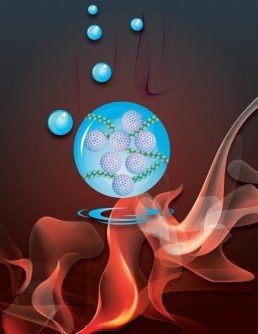Sep 27 2016
 An artistic interpretation of the cold sintering of ceramic particles (white) and polymer strands (green) using low heat to evaporate added water molecules (blue). Credit: Jennifer M. McCann/MRI
An artistic interpretation of the cold sintering of ceramic particles (white) and polymer strands (green) using low heat to evaporate added water molecules (blue). Credit: Jennifer M. McCann/MRI
Penn State researchers have developed a new technology called Cold Sintering Process (CSP), which has opened the ability to merge incompatible materials like plastics and ceramics into useful, new compound materials, and also to decrease the energy cost of several types of manufacturing.
Ceramic is the oldest man-made material dating back tens of thousands of years. Since then almost all ceramics have been produced by heating them to high temperatures, either by sintering ceramic powders in furnaces or firing in kilns, both of which need increasing amounts of energy.
In this day and age, when we have to be incredibly conscious of the CO2 budget, the energy budget, rethinking many of our manufacturing processes, including ceramics, becomes absolutely vital. Not only is it a low temperature process (room temperature up to 200 degrees Celsius), but we are also densifying some materials to over 95 percent of their theoretical density in 15 minutes. We can now make a ceramic faster than you can bake a pizza, and at lower temperatures.
Clive Randall, Professor of Materials Science and Engineering, Penn State
The journal Advanced Functional Materials featured an article where Randall and his coauthors explain the co-sintering of ceramic and thermoplastic polymer composites with the help of CSP. The diversity of applicable materials was highlighted by selecting three types of polymer that helped complementing the features of three types of ceramics, a semiconductor, an electrolyte and a microwave dielectric.
The new possibilities for dielectric property design, including both ionic and electronic electrical conductivity design were demonstrated by these composite materials. It is possible to sinter these composites to high density at 120°C within 15 to 60 minutes.
Just Add Water
According to the researchers, the process begins with wetting ceramic powder with just a few drops of acid solution or water. This is followed by decomposing and partially dissolving of the solid surfaces of the particles in the water in order to develop a liquid phase at particle-particle interfaces.
The addition of pressure and temperature results in the flowing of water and rearrangement of the solid particles in an initial densification process. In a second process, clusters of ions or atoms move away from the spot where the particles contact each other, which helps diffusion, and then reduces surface free energy, allowing the particles to pack strongly together.
The key here is to become aware of the accurate combination of time, heat, pressure, and moisture to capture the reaction rates so that the material completely crystallizes and reaches an extremely high density.
I see cold sintering process as a continuum of different challenges. In some systems, it’s so easy you don’t need pressure. In others you do. In some you need to use nanoparticles. In others, you can get away with a mixture of nanoparticles and larger particles. It really all depends on the systems and chemistries you are talking about.
Clive Randall, Professor of Materials Science and Engineering, Penn State
The researchers have started to develop a library of the precise techniques that are essential for using CSP on a wide range of materials, with 50 up-to-date verified processes. These include ceramic-metals, ceramic-nanoparticle composites, ceramic-ceramic composites, and also the ceramic-polymers discussed here.
The other areas that are currently open to exploration by CSP are architectural materials, such as ceramic bricks, biomedical implants, thermal insulation and a wide range of electronic components.
“My hope is that a lot of the manufacturing processes that already exist will be able to use this process, and we can learn from polymer manufacturing practices,” Randall concluded.
Co-authors on “Cold Sintering Process of Composites: Bridging the Processing Temperature Gap of Ceramics and Polymer Materials” were postdoctoral scholars Jing Guo and Hanzheng Guo, Ph.D. candidate Seth Berbano, research and development engineer Amanda Baker, and Michael Lanagan, professor of engineering science and mechanics, all part of Penn State’s Materials Research Institute.
The work received support from the National Science Foundation as part of the Center for Dielectrics and Piezoelectrics and the NSF-ERC ASSIST program, the 3M Science and Technology Fellowship and the Department of Energy GATE Fellowship.